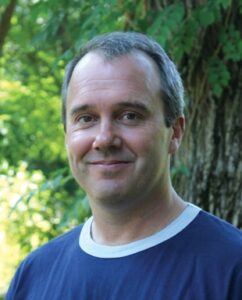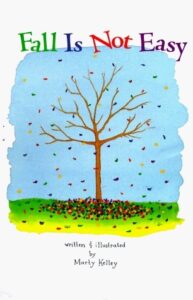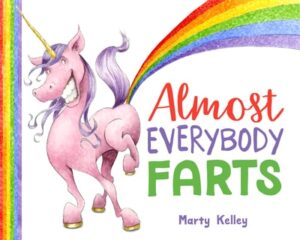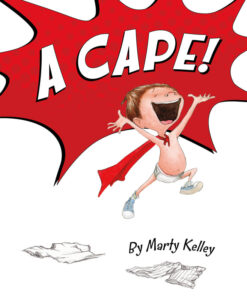 Here’s a little secret about getting interviewed at OPB—if you make books about unicorns, zombies, and farts…you’re in! And while you might think that’s the only reason that author, artist, and teacher Marty Kelley is joining us today, you’d be wrong. He’s also the creator of Imaginary Ancestors, an interactive storytelling project where you get a “brand-new, completely fictional family member into your life.” Awesome, right?
Here’s a little secret about getting interviewed at OPB—if you make books about unicorns, zombies, and farts…you’re in! And while you might think that’s the only reason that author, artist, and teacher Marty Kelley is joining us today, you’d be wrong. He’s also the creator of Imaginary Ancestors, an interactive storytelling project where you get a “brand-new, completely fictional family member into your life.” Awesome, right?
There’s more to Marty than just his knack for weaving the hilarious with the heartfelt. With a background in elementary education and freelance illustration, Marty possesses a unique perspective on storytelling that’s both educational and entertaining. His experiences in the classroom inform his understanding of children’s innate curiosity and humor, aspects that he deftly incorporates into his work. Marty Kelley is a multi-dimensional artist who not only tickles our funny bones but also sparks our imagination and speaks to our inner child.
Oh, and he’s the author of this fine book, which is the first of his I’ve read.
Let’s dive into the interview to find out more about Marty right now!
RVC: Rumor has it that you get your start as an artist by drawing “historically accurate pictures of spaceships dropping bombs on dinosaurs.” True story or is this just more bang-up work from the Office of Disinformation?
MK: 100% true disinformation…
RVC: Hah. Okay. What’s the REAL story?
MK: I’ve always loved to draw. I spent a lot of my school career drawing ridiculous doodles in notebooks and in the margins of my school books. I spent a lot of my recess time erasing those same sketches from the margins of my books. I’ve always enjoyed creating art and stories that exist in some sort of strange juxtaposition with one another. Spaceships and dinosaurs, for example.
RVC: Please share the story of the comic strip you created during high school.
MK: I had high hopes of being the next Gary Larson and creating a comic that could rival The Far Side. To that end, I created a single-panel comic called Major Weirdness. It was exactly as good as a comic from a dorky, untrained 14 year old would be. I sent it to a few syndication houses and a few kindly took the time to send me actual rejection letters instead of just using my comics as place mats.
I eventually decided to start a bit closer to home. I packed up all my comics in a binder, tossed it in my backpack, and rode my bike to the local town newspaper where asked to see the Editor in Chief. The editor took the time to sit down with me and look at my work. After pointing out that I had spelled Weirdness wrong on every panel, she offered to print my comic in the paper once a week, for which I was offered the exorbitant payment of $10 per comic. I still feel like they overpaid me.
RVC: Great story. Now, after high school, you studied animation at The School of the Museum of Fine Arts. Soon after graduating, you returned to school to become a teacher. What’s the backstory here?
MK: My art school years were great and I loved the Museum School, but their unorthodox way of running a school gave me, as an 18-year-old kid, WAAAAAY too much freedom in my choices. Rather than taking several foundation courses in many aspects of art, I was able to focus everything on my tunnel-visioned view of being an animator. I really just burnt myself out on it in two and half years. After a few bumpy attempts at other things, I got a job as an aide in a local elementary school. I absolutely loved working with kids. After following my girlfriend (now wife) to Florida, where I experienced some of the worst jobs of my life (I’m looking at you, Mystery Fun House…), I went back to school to get a “real job” teaching second grade.
RVC: What are some specific ways that being a second-grade teacher prepared you to become a professional writer and illustrator of children’s books?
MK: Honestly, I think my time teaching was one of the most important factors in any success I’ve enjoyed as an author/illustrator. I learned firsthand what kids actually enjoy. I learned how they read and why they make choices that they do in selecting books. As a very frequent presenter at schools, my background as a teacher was invaluable in making me comfortable in front of crowds and understanding how to keep 150 kindergarten kids entertained in a gym for 45 minutes. Something not for the faint-hearted.
RVC: What convinced you to make complete shift to being a story creator?
MK: Lunch duty. You have no idea…
RVC: I can only imagine!
MK: Honestly, I started doing Author Visits to other schools when I was teaching. I’d take a personal day here and there and zip off to another school to talk about books and make some pretty decent money. When I visited the elementary school that I attended as a kid, the largest newspaper in the state came and did a big feature story about it.
When I returned to school the next day, several co-workers suggested that the next time I was “sick,” I try to avoid statewide publicity about it.
The superintendent, however, was delighted by what I was doing and allowed me to continue visiting other schools a few times per year because she could see that I was working hard to promote literacy. I eventually had to start turning down requests because of my pesky day job. It was at that crossroads, just married, in a new home, with a brand new baby boy, that I decided to chuck teaching and throw myself headlong into the breach. It was terrifying and very, very challenging, but I’ve never regretted it for a minute.
RVC: Share the story behind your first published picture book.
 MK: I was working on a few books with no success. Like anybody trying something new, I had no idea what I was doing or how to go about doing it. This was in the olden days before the internet, when dinosaurs roamed freely through our towns. I began haunting the library and bookstores and eventually was able to sell Fall Is Not Easy to a small publisher. I was advised by people in the business that I should try to negotiate a flat fee because books from small publishers rarely sell many copies. I ignored that advice. That first book was in print for over 25 years and did sell a decent number of copies over its life.
MK: I was working on a few books with no success. Like anybody trying something new, I had no idea what I was doing or how to go about doing it. This was in the olden days before the internet, when dinosaurs roamed freely through our towns. I began haunting the library and bookstores and eventually was able to sell Fall Is Not Easy to a small publisher. I was advised by people in the business that I should try to negotiate a flat fee because books from small publishers rarely sell many copies. I ignored that advice. That first book was in print for over 25 years and did sell a decent number of copies over its life.
RVC: I’m glad you bucked the trend there. Terrific! What was the most useful lesson that book taught you?
MK: Don’t lie to a publisher and tell them that the artwork is almost done when you haven’t, in fact, even started it. Rookie mistake.
RVC: You’ve been waiting patiently for me to ask, so here it is. Almost Everybody Farts—great picture book about farts, or the greatest picture book about farts?
 MK: I’m biased, of course, but I’d suggest that it’s the only book about farts that matters.
MK: I’m biased, of course, but I’d suggest that it’s the only book about farts that matters.
RVC: What kind of reception did that manuscript have when you summoned the courage to send it in?
MK: It was a strange mix. That book holds two personal records for me: Fastest rejection and fastest acceptance. When my agent, the incomparable Abi Samoun at Red Fox Literary, sent the manuscript out, we got an email back from a well-known editor at a huge house exactly 28 minutes later. She was NOT a fan of fart books. 7 minutes after that, an offer came in from another publisher, followed by a second offer from a different publisher. It was the first time one of my manuscripts has gone into a bidding war, too.
RVC: What’s your favorite thing about that book (beyond that cool story you just shared)?
MK: Thinking about the fact that in a law office somewhere, a lawyer actually had to write an eleven-page legal contract that had the word “fart” in it about 57 times. That, and the fact that it makes kids laugh so hard. It’s really a joy to share that one at schools and see the kids shriek with laughter.
RVC: You and I know that tons of things don’t make it to the final product when we’re talking about picture books. So, what didn’t make it into that book that you wish did?
MK: HA! On the endpapers, there are a bunch of random people farting. Doctor, yoga instructor, princess, etc. When I originally submitted those pages, they included a nun. She made it through the first round of edits, but then the lawyers got involved. It was decided (not by me) that the book was potentially controversial enough without including a flatulent nun. There was also a page where an uncle was farting directly in a kid’s face. The marketing people thought it was “too aggressive.”
RVC: I think they missed a hilarious opportunity there.
MK: I still disagree with the marketing folks, but we all need to learn to compromise.
RVC: Let’s talk process. How do you go about creating a picture book?
MK: I really don’t have a set process. I tend to be a bit unfocused overall, flitting from one thing to another. I’m very curious and really enjoy trying new things. Very basically, I usually start with words. I will scrawl ideas and concepts in my sketchbook. Sometimes they seem to just flow, but much more often, it is a process that takes months or years. I heavily revise everything I create. I typically have pictures in mind, but they tend to get made after the words are finished unless I’m working on a graphic novel. Those are a totally different creative process for me. I think those through almost like a movie or TV show, relying much more heavily on pictures to tell the story and carry a lot of the humor. I really enjoy process and the act of creating.
RVC: How do you balance the relationship between text and illustrations in your work?
MK: Again, it depends on the book. As I mentioned earlier, I really like work that has some juxtaposition of ideas in it. I like stories where the pictures and words don’t always tell the same story, but they work together to create something new. It’s enjoyable to me to have the illustrations show or suggest something other than what the words are saying. For me, that’s a fun element of humor to exploit and play with.
RVC: Have you ever faced writer’s or artist’s block? If so, how do you overcome it?
MK: Oh, heck yes. It happens to everyone at some point. Often, I will just put the project down and take a break, either by working on something else or just doing something completely different. It can sometimes take years for me to take an idea that I like and turn it into an actual, workable story. I’ve also found over the years that projects I struggle with can occasionally be abandoned in favor of projects that incorporate elements of the original project. Lots of my books contain elements that were scavenged from previous “failures.”
RVC: What’s the most rewarding part of making picture books?
MK: Sharing them with a gym full of kids who laugh hysterically. It’s unimaginable rewarding to realize that something you created is bringing that much joy into the world.
RVC: You’re well known for having terrific school visits/presentations. What are a few of your secret go-to moves (that other writers should maybe copy)?
MK: Be authentic. Don’t try to be something you think kids will like. Be honest and real with them. Also, tell fart jokes.
Seriously, though, don’t tell fart jokes if you’re not the fart joke kind of person. You know when someone is being insincere. Kids do, too.
RVC: I quite agree. What else?
MK: I keep my presentations very visually engaging. I spend weeks every summer crafting a new digital slideshow for school visits. I work very hard refining the presentation and I go into each school prepared and ready to give it my all.
I keep the kids engaged with interactive elements including places for them to shout things out. I cover all aspects of the writing process in an age-appropriate way. You really, really have to have a sense of who you’re talking to. Explaining your personal philosophy of using gerunds as a vehicle to further the exploration of the limits of language to a gym full of kindergarteners is probably not the smartest move a presenter can make. That doesn’t mean talking down to them, but making sure that you’re meeting them where they are with useful information presented in an engaging, appropriate way.
Also fart jokes.
RVC: You seem to have a running gag with the trademark symbol on your website and interviews, so let me just ask. What’s the deal there?TM
MK: What’s the deal there?™ is a trademark owned by Marty Kelley Enterprises, Ltd.. My lawyers will be contacting you.
RVC: On no! I’m terrified™.
MK: It’s just my silly push-back against the ridiculous culture of proprietary nonsense everywhere.
RVC: Fair enough™! Now, what advice would you give to parents, librarians, and educators for selecting quality picture books?
MK: If a celebrity wrote the book or it it’s based on a cartoon series or a movie, maybe keep looking.
RVC: As someone who reads a lot of celebrity books as research (because I write them in my role as The Picture Book Whisperer), I agree with you.
MK: It really depends on what you’re looking for. If you want kids to become enthusiastic lifelong readers, let them choose the books they want. If you think it’s too hard for them, sit with the kid and read it together. If you think it’s too easy for them, take a breath and step back. Not everything has to be a challenge. Not everything needs to be quantified and graded. Let them read what interests them. Suggest other books that may be interest-adjacent as a way to broaden their reading horizons. Reading for pleasure should actually be a pleasure.
RVC: Here’s one last question for this part of the interview. It’s Brag Time! What awesome upcoming things do you want to share with us?
MK: The stuff I’m most excited about lately isn’t book stuff. I do have a new picture book coming out in 2026 that I’m excited about, but lately I’ve been working on a lot of sculptural work that incorporates stone, steel, and wood. It’s a joy to work on these and it’s such a different process than creating on paper with words or images.
I’ve been creating and selling a lot of these sculptures and it’s been a really exciting new avenue of creativity to explore.
RVC: Alright, Marty. Great job on the above, but here’s where your true colors will show. It’s the LIGHTNING ROUND! We’re talking zip-zappy fast questions followed by hustle-bustle quick answers. Are you prepared to face this challenge?
MK: You bet™.
RVC: If we overheard you singing in the shower, you’d be belting out…
MK: “Think” by Aretha Franklin. Also, “Get out of my bathroom while I’m showering!”
RVC: If there was a picture book about your life, what would it be called?
MK: Wait, what?
RVC: Your studio is on fire! What’s the one thing you grab on your way out the door?
MK: The fire extinguisher.
RVC: An industry trend you wish would go away?
MK: It’s a tie: Celebrity “authors” and books created to sell toys.
RVC: The unicorn (or fart or zombie) picture book you WISH you wrote?
MK: Well, I hadn’t really given that any thought, but I think you just made it: Unicorn Fart Zombies™.
RVC: Funniest thing a kid reader of your books said to you?
MK: After presenting for 30 minutes to a group of kindergarten students about how I create my books, a kid raised his hand and asked “Do all wrestlers drive red trucks?”
I have no idea where that came from but I told him, “Yup. With whomping stereos.” and he seemed satisfied with that answer.
RVC: Thanks so much, MartyTM!


